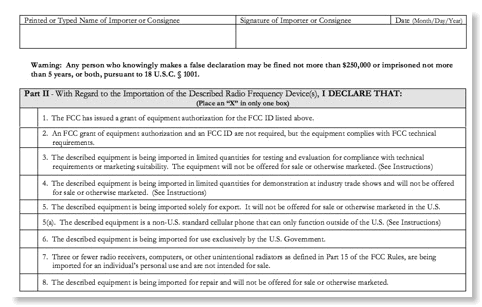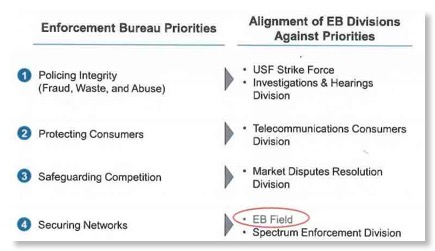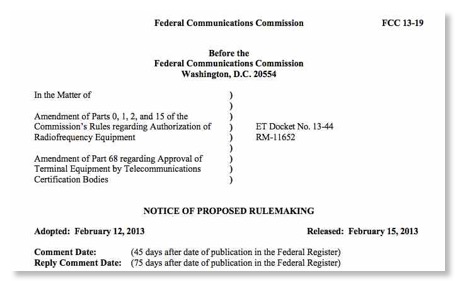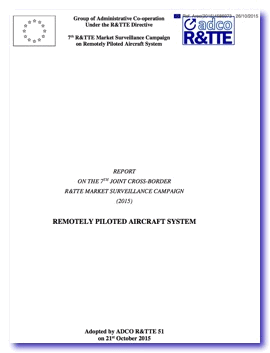EU Market Surveillance Finds High EMC Noncompliance from Present Consumer Drones
- Drones and their use of spectrum
- Enforcement of FCC equipment authorization rules
Every year the EU pick a type of radio equipment for market surveillance to see if actual units are complying with the EU counterparts to FCC equipment authorization rules give in Part 2, Subpart J of FCC's Rules. This year 16 countries (Austria, Estonia, Finland, France, Germany, Greece, Lithuania, Luxembourg, the Netherlands, Norway, Poland, Slovakia, Spain, Sweden, Switzerland and the United Kingdom) cooperatively examined 79 drone models sold in EU territory. 92% of the units tested "were manufactured in countries of the Far East ". The mean price of systems was "between 100 and 200 euro". These units almost all used the 2.4 and 5.8 GHz unlicensed bands, best known for Wi-Fi.
The report observed what has been previously discussed here about the interference potential of drones that are not properly regulated:
Signals transmitted from the air to the ground have a significantly bigger coverage area than from the ground. Therefore, interferences generated from RPAS could have a major impact on radio communication. This means that there is a higher risk of harmful interference if RPAS systems do not meet the essential requirements.
Here is what the EU found about compliance:
The market surveillance authorities found that ninety two percent (92%) of the devices did not fulfil all of the requirements. Half (51%) of assessed RPAS were found to be non-compliant in relation to the effective use of spectrum. Four out of five (82%) had administrative non-compliances within the meaning of the R&TTE Directive.
The campaign showed that the main reasons for non-compliances with the effective use of spectrum were spurious emissions (70%) and radiated power/power density (23%). Furthermore, the figures show that the remote controls on the ground tend to have a higher non-compliance rate than the aircraft systems.
The market surveillance authorities consider the rate of non-compliances too high. The growing market of remotely piloted aircraft systems combined with a low compliance rate could lead to an increase of interferences to the radio spectrum. Market surveillance authorities should therefore continue to check at national level such products and take all appropriate measures to ban non-compliant products from the market. Regular reporting in ADCO R&TTE is recommended.
It is reasonable to assume that most of the models sold in the EU are also sold in the US and that if they don't comply with EU regulations they probably don't comply with FCC ones either. The FCC counterpart of "market surveillance" was reviewed in Docket 13-44 and the rules were tightened in its Report & Order. But it appears that the EU approach is more transparent with eh issuance of reports like that shown above. It also appears that there is central planning of equipment categories to surveil whereas in the US Telecommunications Certification Bodies (TCBs) due surveillance on behalf of FCC and have great discretion in their actions. There is also a conflict here in that TCBs have a supplier relationship to manufacturers/importers who buy their services.
So several questions come from reviewing this EU report:
- Are drones now sold in the US as noncompliant as the ones sold in Europe?
- If so, why haven't the TCBs or the FCC noticed it?
- Does the allegedly overactive Enforcement Bureau have any interest in this matter?
- Will the Wi-Fi community get distracted enough from it present focus on LTE-U issues and recognize this serious threat to its spectrum?
Demise of FCC Form 740 Along with the Rest of Spectrum Enforcement
October 19, 2015 - Order
FCC Form 740 Suspension Order
For those of you not familiar with the Form 740, it is the form needed to import electronics equipment that is FCC-regulated, or potentially FCC-regulated, into the USA. Below is a key section of the form:
Part of present Form 740
Note that the importer or consignee has to certify subject to criminal penalties that the items have been issued a grant of equipment authorization. In view of the recent VW kerfuffle perhaps FCC should up the ante and require a statement both that there is a grant and that the equipment has hardware and software that is consistent, within normal commercial practices, with what was approved by FCC - which is most cases was actually a TCB operating on behalf of FCC.
FCC had previously proposed to delete the Form 740 filing requirements in the NPRM of Docket 15-170 stating (at para. 119)
We also question whether the Form 740 requirement continues to be useful for us to identify non-compliant RF devices and take appropriate follow-up action. The continuation of the burden of filing Form 740 no longer appears justified and we propose to eliminate the requirement. We seek comment on this conclusion and the observations on which it is based. Parties are invited to identify any benefits we could derive by continuing to collect the Form 740 information, in its current form or a modified form, and specifically to comment on whether and how any of the underlying objectives of our equipment authorization program would go unmet if we eliminate our existing means of collecting this data.
While the form may not allow ready identification of "non-compliant equipment", the threat of criminal prosecution under 18 USC § 1001 might be a real deterrent to such importation if FCC really cared about spectrum enforcement. But as we have written recently there are serious questions whether FCC cares about any type of spectrum enforcement.
Recall the chart from the consultant's report used to justify spectrum enforcement downsizing that we have used several time before:

Spectrum seems to be EB's lowest priority. And what little interest they have seems to be ex post facto enforcement of public safety interference, with maybe a little time for broadcast pirates. Ex ante enforcement of equipment marketing has been low on both OET's and EB's agenda for more than a decade.
Now Marcus Spectrum Solutions LLC does not own any Title III radio licenses, let alone ones that are worth billions of dollars. But since the fair market price of spectrum is in the range of $0.50 - $2/MHz-pop there certain are firms - and maybe even individuals - who own billions of dollars worth of licenses. But if I was responsible for such licenses and accountable to shareholders I would be very nervous about the sudden demise of the Form 740 along with FCC's ever shrinking interest in all spectrum enforcement.
The Report and Order in Docket 13-44 had some improvements related to enforcement and post-market samples: it allowed for some FCC involvement in TCB sampling of production units (para. 27), but it still limits sampling to 5% and does not address purchasing units at the retail level where they can not be tampered with as in the case of "lab queens"/"golden apples" that are selected for testing because of superior performance or possibly even modification à la VW emission tests. It also requires that TCBs only test units made by their own clients - a certain conflict of interest.
So given FCC decreasing interest in spectrum enforcement, the new 740 Order should be no surprise, but maybe the major spectrum licensees as well as legitimate manufacturers of radio equipment should challenge it forcefully?
Equipment Authorization NPRM: 1st Comments Deal with Enforcement
 Today the comments of Marcus Spectrum Solutions LLC in the Equipment Authorization Rulemaking, Docket 13-44, were posted on the Commission’s comment website, ECFS. These comments were the first filed and were filed early in an attempt to raise a key issue in this proceeding: the enforcement mechanism of rules must be credible in order to deter the introduction of noncompliant equipment into the US wireless market. The present equipment authorization rules are outdated and lack credibility with respect to enforcement because of changes in both the marker for wireless equipment and the technology used today.
Today the comments of Marcus Spectrum Solutions LLC in the Equipment Authorization Rulemaking, Docket 13-44, were posted on the Commission’s comment website, ECFS. These comments were the first filed and were filed early in an attempt to raise a key issue in this proceeding: the enforcement mechanism of rules must be credible in order to deter the introduction of noncompliant equipment into the US wireless market. The present equipment authorization rules are outdated and lack credibility with respect to enforcement because of changes in both the marker for wireless equipment and the technology used today.The real threat of continuing the current basic structures is twofold:
- Noncompliant equipment’s market share could increase and discourage compliance by legitimate manufacturers due to both price pressure and rapid copying of legitimate equipment.
- Noncompliant equipment could cause the very interference problems that the Commission’s Title III rules were designed to prevent!
The comments suggest changes in 4 areas:
- Criminalize the submission of fraudulent postmarket samples. FCC has never taken serious action against manufactures/imported who submit doctored samples.
- Codify key terms of KDB Publication No. 610077 and increase post-market sampling rate of TCBs. This obscure publication includes key requirements for TCBs to sample equipment on the market. Sampling should be increased above the present 5% and the requirements should be codified in the FCC Rules to make them clear to all
- Address TCBs’ basic conflict in post-market testing. Recognize that TCBs have conflicting incentives to identify their customers’ possible noncompliance
- Make post-market surveillance credible by including consistent retail sampling. In almost all cases FCC only tests samples provided by manufacturers/importers who have incentive to doctor noncompliant equipment on to test large numbers to find one that is atypical. FCC is urged to require TCBs to do some testing of models acquired from retail or wholesale sources at random. The widespread use of software to control transmitter parameters means that it is much easier to doctor a test sample now than it was when these rules were originally formulated.
It is hoped that other parties interested in this proceeding, especially groups representing licensees will consider these concepts and give their views on such topics in their own comments/reply comments.
FCC's Ambivalent Views on Equipment Enforcement

Last week I gave an invited talk at the American Council of Independent Laboratories” (ACIL) 2012 Policies & Practices Conference. ACIL is the trade organization that represents private testing labs including the ones active in the FCC’s equipment authorization program, which FCC describes as
“The FCC oversees the authorization of equipment using the radio frequency spectrum. These devices may not be imported and/or marketed until they have shown compliance with the technical standards specified by the commission.”
The talk was entitled “Enforcement in the Digital Age”. Readers may recall that equipment marketing enforcement has been a recurring theme in this blog. While FCC sometimes lashes out with dramatic equipment marketing enforcement actions, in general FCC seems to turn a blind eye to such enforcement issues, relying almost exclusively on a complaint-driven process. FCC bureaucrats have learned that enforcement usually makes somebody angry, the perpetrator, who then hires a big law firm. Unless there is somebody who is pleased by the enforcement, a big complainant for example, the principle of “aggravation minimization” dictates don’t get involved.
Oddly, the major trade associations, NAB, CTIA, TIA, and CEA, seem to have little or no interest in equipment enforcement, except perhaps for the case of jammers. As a result there is essentially no independent surveillance of marketing of noncompliant equipment other than the recent (long overdue) initiative on cellular and GPS jammers. Enforcement Bureau staffers do not spot check retailers for noncompliant equipment. They don’t even go to the annual Consumer Electronics Show. There is a small amount of market surveillance by TCBs, but, as discussed in slides 16-17 this is minimal and hopelessly affected by intrinsic conflicts of interest.
The FCC Lab does not routinely call in equipment for post approval testing or ask manufacturers for copies of test data for equipment subject to Verification or Declaration of Conformity. During my tenure such events were very rare and may well continue to be very rare. Indeed, as I pointed out in my talk (slide 18 ), the labels on equipment subject to Verification or Declaration of Conformity do not necessarily contain enough information to even identify who the “responsible party” is that is supposed to have the test data. This if a suspicious unit were to be bought at a retailer - another unlikely event - it can be difficult to trace the source under present rules.

The issue of “lab queens” was discussed (Slide 15). “Lab queens” does not refer to the possible life style of FCC employees, rather it refers to test samples of equipment that are atypical of the actual production equipment. This could result from either testing many units and selecting the one with the best performance or by intentionally modifying a production, for example to decrease its power. This actually happens and so far has never resulted in a major penalty. I proposed criminalizing this behavior by requiring a sworn affidavit from a US resident stating that the unit was normal production unit taken from normal inventory. Further I proposed that FCC be authorized to request a “coupon” good for a unit of equipment at any retail dealer. This would allow FCC for the first time to get reliable samples of production equipment for sampling.
I pointed out that FCC keeps saying that it will modify its rules quickly when new types of equipment-related interference are actually encountered. This is just not credible. In the case of police radar detector interference to VSAT systems it took over 10 years for FCC to react. In the ongoing case of interference from early generation bidirectional cellular amplifiers if has taken more than 5 years and there still is no action so marginal manufacturers can still make the original designs although reputable manufacturers have eliminated the problem through design changes. I urged a regular public report on “emerging interference issues” which are not even well disseminated within FCC staff at present. (Slides 9-10)
Presently unregulated amplified
TV antenna with 55dB gain!
I ended the presentation with an open question: why do the major trade associations with an apparent interest in orderly spectrum use (CTIA, NAB, TIA, CEA) remain so silent on the issue? Is reasonable progress possible?





![Validate my RSS feed [Valid RSS]](valid-rss-rogers.png)

